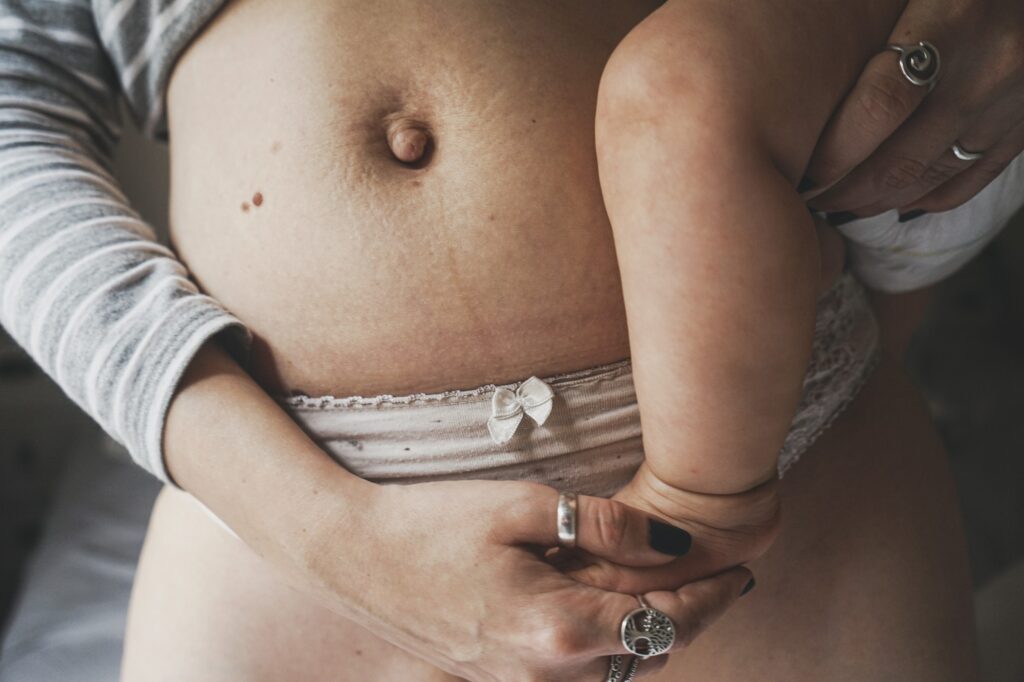Are you preparing for childbirth and concerned about experiencing vaginal tearing? While it is a common occurrence during delivery, it is understandable to want to minimize the risk and prevent the pain and discomfort that can come with it.
Fortunately, there are ways to reduce the likelihood of tearing and promote a smoother birth experience.
In this article, we will explore the causes and types of vaginal tears, as well as preventative measures that can be taken to reduce the risk of tearing during childbirth.
We understand that the thought of vaginal tearing can be daunting and even scary, but by educating yourself and taking proactive steps, you can feel more confident and empowered in your journey toward motherhood.
So, let’s dive in and learn about how to prevent tearing during delivery.

Understanding Vaginal Tearing
To understand vaginal tearing during childbirth, it’s important to consider the risk factors that can increase the likelihood of tearing. These factors include being a first-time mother, delivering a larger baby, and prolonged labor.
In addition, the position and size of the baby and the use of delivery tools like forceps or vacuum can also play a role in vaginal tearing.
Role of Baby’s Position and Size
The position and size of the baby play a significant role in the likelihood of vaginal tearing during childbirth. Larger babies can cause tearing during delivery.
When the baby is in a posterior position, or facing the mother’s abdomen, it can put more pressure on the perineal area, increasing the risk of tearing. In contrast, when the baby is in an anterior position, or facing the mother’s back, it can reduce the pressure on the perineum.
Certain birthing positions can also affect the likelihood of vaginal tearing. Squatting, for example, can increase the risk of tearing because it puts more pressure on the perineal area. On the other hand, hands and knees, supported sitting, or side-lying positions can minimize the risk of tearing.
Swollen perineal tissue and a speedy delivery are also common factors. Additionally, the size of the mother’s perineal tissue can also affect the likelihood of tearing. Regular perineal massage during the final weeks of pregnancy can help to stretch and prepare the tissue for delivery, reducing the risk of tearing.
Influence of Delivery Tools
Delivery tools like forceps and vacuum-assisted delivery can increase the chances of vaginal tearing during childbirth. These tools are often used when a baby is having difficulty being born or if the mother is experiencing complications during delivery. However, they can also cause perineal trauma, which can lead to long-term complications for the mother.
Vacuum-assisted delivery involves a suction cup being attached to the baby’s head, while forceps delivery involves the use of tongs to guide the baby out of the birth canal. Both methods can cause trauma to the perineum, leading to tears that can range from first-degree to fourth-degree tears.
Episiotomy, a surgical incision made to enlarge the vaginal opening, can cause severe vaginal trauma. It is important for healthcare providers to weigh the risks and benefits of using these delivery tools and to inform the mother about the potential risks of perineal trauma.
Types of Vaginal Tears
When it comes to vaginal tearing during childbirth, it’s important to understand the different types of tears that can occur. Tears are typically categorized into four degrees, with first-degree tears being the least severe and third or fourth degree tear being the most severe.
While most tears are minor, third and fourth-degree tears can have long-term effects and are more likely to occur during vacuum-assisted or forceps deliveries.
Common Tear Types
One way to understand the impact of tears during childbirth is to become familiar with the different types of tears that can occur.
First-degree tears involve only the lining of the vagina and are the most common.
Second-degree tears involve deeper layers and pelvic floor muscles, while third-degree tears involve all deeper layers and run into the anal sphincter.
The most severe tears are fourth-degree tears, which go through all deeper layers, the anal sphincter, and extend to the rectum.
Healing time and pain management can vary depending on the severity of the tear, and postpartum care is crucial for both physical and emotional recovery.
Pelvic floor therapy is often recommended for severe tears, as it can improve long-term issues.
In addition to medical treatment, at-home care can help with healing and pain management. Stool softeners and Dermoplast can provide relief, and rest is important for postpartum recovery.
It’s essential to take care of yourself during this time, both physically and emotionally, and to seek support from loved ones.
Severe Tears Incidence
Now that you’re aware of the different types of tears that can occur during delivery, it’s important to understand the incidence rates of severe tears.
While most tears are minor, 2-4% of women experience third or fourth-degree tears that can have long-term effects on their health and well-being.
Several risk factors increase the likelihood of severe tearing, including first-time pregnancies, vacuum or forceps delivery, a prolonged second stage of labor, and large infant head circumference.
If you do experience a severe tear, treatment options may include antibiotics, stitching, and follow-up appointments. Recovery can be a painful and lengthy process, it is best to work with a pelvic floor therapist to create a safe and effective recovery plan.
Preventing Tearing During Childbirth
If you’re a pregnant woman preparing for childbirth, you may be wondering how to prevent vaginal tearing during delivery. Fortunately, there are several techniques that can help reduce your risk.
Perineal massage, controlled pushing, and warm compress usage can all be effective, as well as proper pregnancy hydration and nutrition, and safe birthing positions.
By taking these steps to prepare for childbirth, you can improve your chances of having a safe and comfortable delivery.
Perineal Massage
To reduce the risk of vaginal tearing during childbirth, regularly practicing perineal massage in the final weeks of pregnancy can be effective in preparing the perineum for delivery. This technique involves gently massaging the perineum, the area between the vagina and anus, to help stretch and loosen the muscles and tissues.
Technique: Wash your hands thoroughly and apply a water-based lubricant or oil to the perineum. Insert two fingers about an inch into the vagina and gently massage the area in a U-shaped motion for 5-10 minutes, 1-2 times a day.
Timing and discomfort: Start practicing perineal massage around 34 weeks of pregnancy and continue until delivery. You may experience some discomfort or pressure during the massage, but it shouldn’t be painful. If you have any concerns or questions, talk to your healthcare provider for guidance.
Controlled Pushing
Practicing controlled pushing techniques can help mothers feel more empowered and in control during the birthing process. Mindful pushing involves being aware of the sensations in your body and using your breath to guide the delivery of your baby. Perineal stretching can also be incorporated during controlled pushing to help prepare and prevent tearing. This involves gently stretching the perineum during contractions to help ease the baby’s passage through the birth canal.
To practice controlled pushing, it’s important to communicate with your healthcare provider and birth team to ensure they are aware of your preferences. Relaxation techniques, such as deep breathing and visualization, can also aid in controlled pushing. Supportive birthing positions, such as squatting, hands and knees, or side-lying, can help reduce the risk of tearing as they allow for more space in the birth canal. By incorporating these techniques, mothers can feel more in control and confident during the birthing process, resulting in a more positive experience.
Warm Compress Usage
Using warm compresses can be a beneficial way to reduce pain and increase comfort during childbirth. This method involves applying a warm, wet cloth or compress to the perineum while pushing.
Warm compresses can help to relax the muscles in the perineum, which can reduce the risk of tearing. The warmth also increases blood flow to the area, which can aid in healing postpartum.
The timing and frequency of using warm compresses can vary depending on personal preference and the advice of your healthcare provider. Some women find that using warm compresses during the pushing stage is most effective, while others prefer to use them throughout the entire labor process.
It’s important to note that while warm compresses can be effective, there are alternative methods to reduce tearing and increase comfort during childbirth. It’s important to discuss all options with your healthcare provider and weigh the benefits and drawbacks of each method.
Vaginal Tearing Recovery
When recovering from vaginal tearing, there are immediate treatments that can be done in the delivery room or procedural room, as well as at-home treatments that can be done to help ease the pain and discomfort. Rest is also important for postpartum recovery.
While some severe tears can cause long-term issues, pelvic floor therapy can improve these issues. It’s important to take care of yourself during this time and seek medical advice if needed.
Immediate Treatments
For immediate relief and healing from vaginal tearing during childbirth, your healthcare provider may administer antibiotics and perform stitching in the delivery or procedural room. Antibiotic use can help prevent infection, while stitching can help close up the tear and promote healing. Pain management options, such as using ice packs or taking over-the-counter pain medication, may also be recommended to help manage discomfort.
After delivery, it’s important to attend follow-up appointments with your healthcare provider to ensure that the tear is healing properly. Your provider may recommend certain postpartum care measures, such as using stool softeners to reduce strain during bowel movements and applying Dermoplast to the affected area for pain relief.
It’s important to keep the area clean and dry and to avoid activities that may put a strain on the healing tissue, such as heavy lifting or strenuous exercise. With proper care and treatment, most vaginal tears will heal within a few weeks to a few months.
At-Home Treatments
There are various natural solutions and alternative therapies that can help with the healing process and provide relief from pain and discomfort. These DIY treatments can also prevent further tearing and reduce the risk of infections.
One of the most effective at-home remedies for vaginal tearing is a sitz bath, which involves soaking the perineal area in warm water with added salts or herbs. This can help reduce inflammation and promote healing. You can also use ice packs or cold compresses to reduce swelling and pain.
It’s important to maintain good hygiene and keep the area clean and dry, but avoid using harsh soaps or douching. Eating a healthy diet with plenty of nutrients and staying hydrated can also aid in the healing process.
Don’t hesitate to talk to your healthcare provider about any concerns or questions you may have about at-home treatments. Remember, taking care of yourself after childbirth is crucial for a smooth recovery and overall well-being.
Importance of Rest
To fully recover from childbirth and heal from vaginal tearing, your body needs rest and relaxation. After giving birth, it’s important to take time to rest and allow your body to recover. This means taking a break from household chores, work, and other responsibilities. You may need to ask for help from friends or family to ensure that you have enough time to rest.
Rest is essential for postpartum recovery. It can help reduce pain and discomfort, improve your mood, and promote healing. In addition to rest, pelvic floor therapy can also be helpful in recovering from vaginal tearing. This type of therapy focuses on strengthening the pelvic floor muscles, which can help improve bladder and bowel control, reduce pain, and improve sexual function. Recovery time varies depending on the severity of the tear, but with proper rest and care, many women are able to recover fully and return to their normal activities. Pain management is also important during this time, and your healthcare provider can provide you with guidance and support to manage any discomfort you may experience.
Long-Term Issues and Therapy
As you continue on your postpartum journey, exploring therapy options for any long-term issues related to childbirth can be like discovering a hidden treasure trove of healing and support.
One of the most common long-term issues that women face after childbirth is pelvic floor dysfunction, which can cause incontinence and discomfort.
Postpartum therapy can help you address these issues through a variety of techniques, including pelvic floor exercises, scar tissue management, and incontinence management.
Pelvic floor exercises can help strengthen the muscles that support the pelvic organs and improve bladder control.
Scar tissue management can also help alleviate discomfort and improve flexibility in the pelvic area.
Incontinence management techniques, such as bladder retraining and pelvic floor muscle training, can help you regain control over your bladder.
By working with a postpartum therapist, you can develop a personalized treatment plan that addresses your specific needs and helps you achieve optimal pelvic health.
Conclusion
When it comes to preventing vaginal tearing during childbirth, communication with your healthcare provider is key.
By discussing your concerns and options with your provider, you can make informed decisions about your birth plan. Additionally, having knowledge and tools at your disposal can greatly impact your birth experience and reduce the risk of tearing.
Remember to take care of yourself during this time by practicing good self-care habits, such as staying hydrated, getting enough rest, and talking to your healthcare provider about any concerns you may have.
By remaining proactive and informed, you can make your journey to motherhood as smooth and comfortable as possible.
We hope this article has provided you with valuable information and insight into how to prevent tearing during childbirth.






